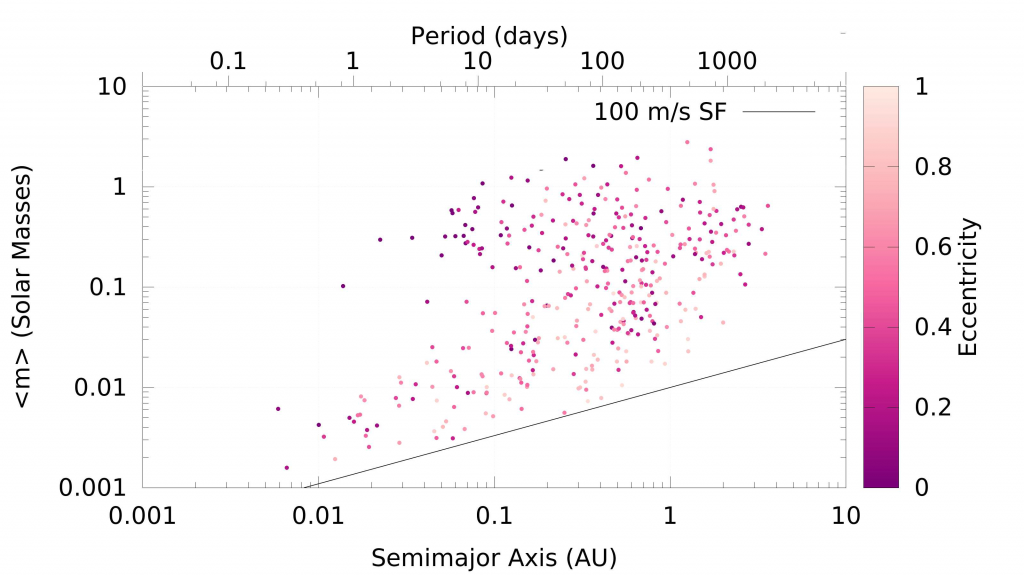The binary program aims to identify and characterize stellar and substellar companions of stars across the HR diagram. To characterize systems, many epochs of observations are needed to sample the stellar radial velocity over time. This program exclusively uses the APOGEE spectrograph because of its superior spectral resolution. Stellar types explicitly targeted in this program include red giants, subgiants, and M dwarfs.

Stars generally fall into one of two targeting categories. Stars with existing multi-epoch observations in legacy APOGEE surveys form the “long baseline” sample, whereas stars with no previous APOGEE observation form the “short baseline” sample. The “short”/”long” naming convention refers to the total temporal baseline and can seem counterintuitive, since short baseline targets require more epochs of observation during SDSS-V.
In the long baseline sample, stars were priority ranked to increase the representation of certain non-red giant stellar types of interest (since red giants are expected to dominate the short baseline sample) and devalue some classes of main sequence stars (either unsuitable for precise radial velocity measurements or already well studied by most traditional exoplanet surveys). The following ranking criteria were applied using stellar parameters measured by ASPCAP:
- Low mass dwarfs: Teff < 4500 K and log g ≥ 4.0
- Subgiants: 4.0 < log g < 3.5
- Red Giants: log g > 3.5
- Other/ log g unknown
Cartons
Binary Cartons in Targeting Generation v0.5.3
The long baseline carton selected stars that had been previously observed during the APOGEE-1 and/or APOGEE-2 surveys in at least three separate epochs as of the DR16 data release. They are selected from the mos_sdss_apogeeallstarmerge_r13 table found both on CasJobs and on the SAS. This “allStarmerge” file uses the information in APOGEE DR16’s allStar and allVisit summary files to consolidate duplicate entries of single targets (which occurs when targets are observed in more than field) to facilitate targeting for SDSS-V. The allStarMerge file was constructed as follows:
- Targeting information common to all entries (e.g. APOGEE_ID, coordinates, proper motions, etc.), is directly copied from the first entry for the star in the allStar file, while information that differs (e.g. FIELD) is concatenated in a space-separated string.
- Radial velocity information (VHELIO_AVG, VSCATTER, etc.) were derived or copied (into a space-separated string) from the allVisit entries for a given star.
- ASPCAP-derived stellar parameters (Teff, log g, & metallicity) are averaged (weighted by SNR) from the individual entries for the star in the allStar file. If an entry did not have stellar parameters, it was excluded from the average.
- The text-based TARGFLAGS, STARFLAGS, & ASPCAPFLAGS were concatenated from the star’s individual entries in the allStar file with repeated flags removed.
- mwm_rv_long_fps
- Target in the allStarMerge file.
- H < 11.5
- nvisits (in APOGEE-1 and/or 2) > 3
- TARGFLAGS includes one of the following values:
- APOGEE_SHORT
- APOGEE_INTERMEDIATE
- APOGEE_LONG
- APOGEE2_BIN
- Gaia-based distance
The short baseline carton selected stars never previously observed with APOGEE and applied color magnitude cuts combined with photometric quality cuts to select stars similarly to the earlier APOGEE surveys using both the 2MASS Point Source Catalog and the AllWise Source Catalog. Definitions of the 2MASS photometric flags and quality measurements can be found at the User’s Guide to the 2MASS All-Sky Data Release. The short baseline cartons were more limited in magnitude so that they would not require more than one exposure at each epoch.
- mwm_rv_short_fps
- H < 10.8
- J – Ks – (1.5 * 0.918 * (H – W2 – 0.05)) >= 0.05
- J_msigcom < 0.1
- Ks_msigcom < 0.1
- H_msigcom < 0.1
- W2_sigmpro < 0.1
- 2MASS ph_qual any of the following: AAA, AAB, ABA, BAA, ABB, BAB, BBA, BBB
- 2MASS gal_contam = 0
- 2MASS cc_flg = 0
- 2MASS rd_flg any of the following: 111, 112, 121, 211, 122, 212, 221, 222
- 2MASS prox >= 6
- Gaia DR2 parallax exists
- Does not match a source in the 2MASS extended catalog
Cadences
Stars with legacy observations (long baseline targets) can have a variety of cadences depending on the target brightness and how many previous epochs of APOGEE observations exist; however, all targets will obtain at least six new epochs in SDSS-V to take advantage of the improved radial velocity precision. Stars with H > 10.8 require two exposures per epoch to reach the needed S/N for precise radial velocities per epoch. Cadences can include:
- bright_6x1
- bright_6x2
- bright_9x1
- bright_9x2
- bright_12x1
- bright_12x2
- bright_15x1
- bright_15x2
Short baseline targets are selected to be bright enough to require only a single exposure, and all use the bright_18x1 cadence.
